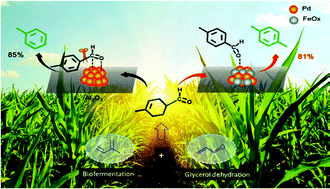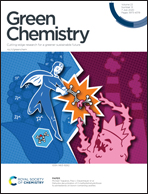Selective production of bio-based para-xylene over an FeOx-modified Pd/Al2O3 catalyst†
Abstract
para-Xylene (PX) is a basic building block of polyethylene terephthalate, which is currently produced from petroleum resources. Developing a renewable route to PX is highly desirable to address both economic and environmental concerns. Several attempts used noble metal catalysts, e.g. Pd/Al2O3, to synthesize PX from biomass-derived 4-methyl-3-cyclohexene-1-carboxaldehyde (4-MCHCA), but suffered from a severe decarbonylation reaction, resulting in toluene as the main product. In this paper, we report an FeOx modification strategy to suppress the decarbonylation reaction on a Pd/Al2O3 catalyst, leading to a drastic shift in selectivity towards PX with a yield up to 81% via a cascade dehydroaromatization–hydrodeoxygenation (DHA–HDO) pathway. Characterization and control experiments revealed that the electron density of Pd sites decreased in an FeOx-modified Pd/Al2O3 catalyst compared to Pd/Al2O3, thus tuning the preferential adsorption mode of the substrate from η2-(C,O), the key transition state of the decarbonylation reaction, to the η1-(O) mode that favors the hydrodeoxygenation process. Notably, this designed catalyst is highly stable and is readily applicable in the selective synthesis of a broad range of desired aromatic chemicals via the same DHA–HDO pathway from cyclohex-3-enecarbaldehyde derivatives. Overall, this work develops a controllable catalyst modification strategy that tailors an efficient catalyst for petroleum-independent bio-PX synthesis.



 Please wait while we load your content...
Please wait while we load your content...